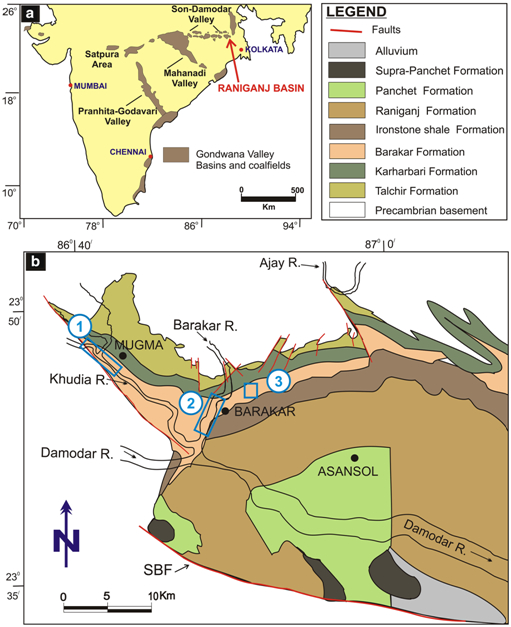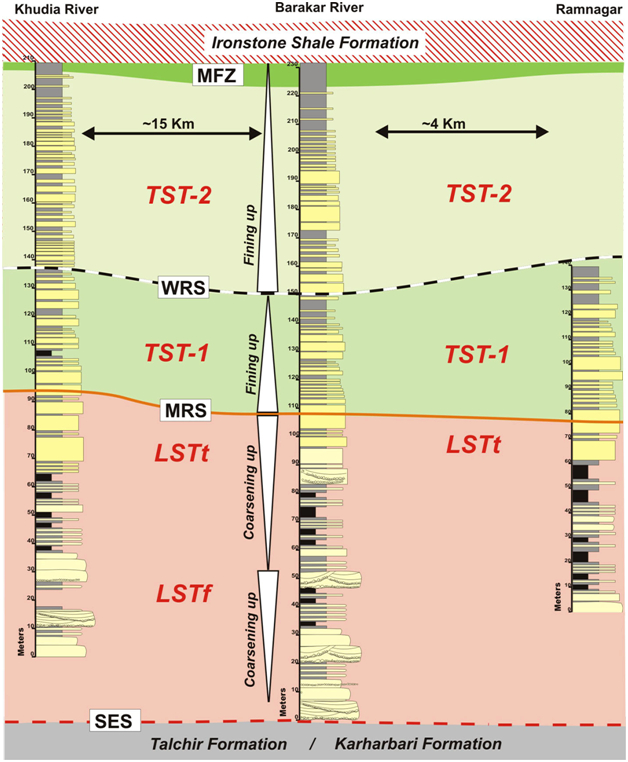Barakar Fm
Type Locality and Naming
Barakar river section, Raniganj coalfield (Oldham, 1861). [Original Publication: Oldham, T. 1861. Mineral statistics of India-I. Coal. Mem. Geol. Surv. Ind. 3(1), 1-12.]
[Figure 1: (a) Map showing the distribution of the Gondwana basins in peninsular India (red arrow pointing to Raniganj Basin). (b) Geological map of part of Raniganj Basin showing the occurrence of different Gondwana lithounits. The study areas are marked as 1: Khudia River, 2: Barakar River, and 3: Ramnagar–Chapatoria open pit area (maps adapted from Bhattacharya et al., 2018)]
Lithology and Thickness
Coal and Sandstone. The base of the Barakar comprises of quartz-pebble conglomerate/pebbly sandstone with sediments becoming finer grained towards top. The sandstone is grey to white to yellow or brown in color, gritty to pebbly with moderate to high matrix and is cross-bedded. Interbedded with sandstones are siltstones and shales, occasionally carbonaceous shale, fire clays and coal seams. Thick coal seams are invariably restricted to the lower and middle part. Thickness varies from 1100 m in Jharia coalfield to 750 m in Raniganj Coalfield.
Relationships and Distribution
Lower contact
The contact with the underlying Karharbari Fm is gradational. The separation of Barakar and Karharbari formations is based on floral contents.
Upper contact
Barakar Formation is disconformably overlain by the Barren Measures Fm.
Regional extent
Barakar and its equivalents have been recorded from all basins of Lower Gondwana successions in Peninsular India.
GeoJSON
Fossils
Following fossils are recorded from Barakar Formation-: Ichnofossils: Thalassinoides, Diplocriterion, Skolithos, Arenicolites, Rosselia (Mukhopadhyay, 1996); Estheriid: Leanid (Ghosh et al. 1988); Acritarchs: Leiosphaeridia, Peltacystia, Balmella, Brazilea (Venkatachala, 1986); Lammellibranch: Anthracanauta (Ghosh, 1971; Mukherjee, 1973);
Flora: Glossopteris and Vertebraria dominate (Maithy, 1974 a, b, C; Bose et al., 1989) whereas Gangamopteris and Neoggerathiopsis are rare that dominated the preceding Karharbari Formation. Phyllotheca, Sphenophyllum, Tryzygia, Gondwanophyllum, Neomariopteris hughesi, Walkomiella, Eretmonia kanranpurensis, Dictyopteridium sporiferum, Barakroxylon and Araucarioxylon are also recorded (Fiestmantel, 1879 b; Seward and Sahni, 1920; Surange and Singh, 1951; Surange and Lele, 1956; Singh et al., 1998). Among palynoflora, the lower horizons contain Microfoveolatispora, Microbaculispora, Lacinitriletes, the middle part is rich in Cyclogranisporites, Lophotriletes, Brevitriletes, Horriditriltes and apiculate miospores, whereas Faunipollenites dominates younger horizons (Srivastava, 1974 b; Tiwari and Tripathi, 1986; Tewari and Jha, 2006). The assemblage has been grouped in Palynoevent-4 (Kungurian-Ufamian boundary) of Tiwari (1996), which, according to him demarcates the Lower Permian-Upper Permian boundary, and corresponds to biohorizon-VI of Vijaya and Tiwari (1992). (Source Peters, 2009).
Age
Depositional setting
Traditionally, the Barakar Formation was interpreted as a freshwater fluviatile/lacustrine deposits Casshyap, 1979; Veevers & Tewari, 1995). However, in recent times, marine intercalations within the fluvial sequence has been suggested (Maiti et al., 1990; Mukhopadhyay 1996; Bhattacgharya et al., 2012, 2016; 2018). Two major facies associations, channel facies and floodplain facies with repetitive fining upward sequences of sandstone, siltstone, shale and coals are recognized. Each cycle reflects a gradual increase in fluvial accommodation space towards top; characterized by braided system at the bottom and meandering depositional system at the top (Sen and Dey, 2020). Presence of acritarchs indicate marine invasion (Venkatachala, 1986).
It has been suggested during the post- Talchir Fm deposition and early Permian time, the Tethyan strandline has undergone a major regression, which resulted in the deposition of continental fluvial deposits representing the Karharbari Fm and the lower part of the Barkar Formation over the basal glaciomarine Talchir Fm sediments (Veevers & Tewari, 1995; Bhattacharya & Bhattacharya, 2015). Recently, evidences for tidal and storm influences in the continental fluvial succession of Barkar Formation have been documented (Bhattacharya et al., 2012, 2016, 2018) which attest to the presence of open sea close to the Gondwana basins. Two distinct transgressive and regressive sequences have been identified within the Barakar sequence (Bhattacharya et al., 2018; fig. 6).
Additional Information
References
Bhattacharya, B., Bhattacharjee, J., Bandyopadhyay, S., Banerjee, S. & Adhikari, K. 2018. Early Permian transgressive–regressive cycles: Sequence stratigraphic reappraisal of the coal-bearing Barakar Formation, Raniganj Basin, India. J. Earth System Sci. 127:29 https://doi.org/10.1007/s12040-018-0922-7
Fiestmantel, 1879 b ; Ghosh, 1971; Ghosh et al. 1988; James Peters, 2009; Mukherjee, 1973; Mukhopadhyay, 1996; Oldham, 1861; Sen and Dey, 2020; Seward and Sahni, 1920; Singh et al., 1998; Srivastava, 1974 b; ; Surange and Lele, 1956; Surange and Singh, 1951; Tewari and Jha, 2006; Tiwari (1996; Tiwari and Tripathi, 1986 ; Venkatachala, 1986; Vijaya and Tiwari (1992;
[Figure 2: Sequence stratigraphic correlation of the logs of Barakar Formation from Khuda River, Barakar River and Ramnagar. Letter symbols:- SES: subaerial erosional surface, MRS: maximum regressive surface, WRS: wave ravinement surface, MFZ: maximum flooding zone, LSTf: lowstand systems tract (fluvially-dominated), LSTt: lowstand systems tract (tidally-dominated), and TST: transgressive systems tract (Adapted from Bhattacharya et al., 2018)]

